The Razer Blade Stealth Review: Razer Takes On The Ultrabook
by Brett Howse on March 29, 2016 8:00 AM EST- Posted in
- Laptops
- Razer
- Skylake
- Razer Blade Stealth
- eGFX
- Razer Core
- Skylake-U
Display
Razer offers two displays in the Stealth. The lower priced offering is a QHD 2560x1440 panel, which is typically the higher resolution offering on most Ultrabooks. With the 12.5-inch screen, that makes for a respectable 235 pixels per inch. For most notebook tasks, this works well. The default DPI setting is a custom level slightly under 175%, which works well for the screen size. The QHD panel offers 100% sRGB gamut coverage.
However for those that want to take it to eleven, Razer will outfit the higher end models of the Stealth with a UHD 3840x2160 display. Considering the compact 12.5-inch screen, that works out to a smartphone-esque 352 pixels per inch. Razer isn’t the only company to offer UHD at this screen size, but it does put them right at the top of the heap when it comes to pixel density on a notebook. I’ll admit I was skeptical that this was necessary, because there are certainly downsides of such a high resolution as well, but seeing both units side by side, I can pretty easily see how much sharper the UHD model is even with my old eyes. The UHD display also covers 100% of the much larger Adobe RGB color space.
Here is kind of where we run into an issue though. Most notebooks that offer 100% Adobe RGB color space support also offer a way to switch the notebook from one color space to another – namely the sRGB color space – which is what is used for most of the web and many applications, while the wider gamuts are for use when needed for doing photo work in color space-aware applications. That is not the case with the Stealth though. It offers no extra functionality for this and that means it is in Adobe RGB mode all the time.
Now, it’s easy to fault Razer here, and of course they should have provided an sRGB if they were going to go down this path. Since pretty much everything is created for sRGB, viewing sRGB images on an Adobe RGB gamut display can cause duller images that you would expect, which is kind of the opposite result that you would want. The Adobe RGB color space is much more vibrant than sRGB and viewing appropriate images in Adobe RGB is very appealing. However, we are kind of at a transition point where sRGB is what most things are, but we are finally getting LED based monitors which can cover a wider gamut.
The real solution here is that Windows 10 needs to do a better job with wide gamut displays and correctly mapping a sRGB image into the wider space, but at the moment it doesn’t do that. We’ve seen a rise in standards which require a wider gamut, like DCI-P3 and the very wide Rec. 2020, but Windows’s handling of these makes it very much up to the application. Hopefully we’ll see some movement there from Microsoft.
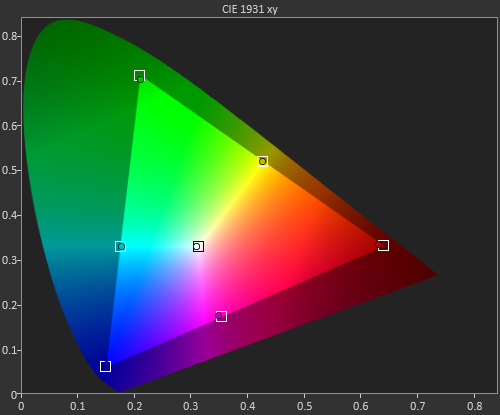
Example of Adobe RGB Color Space
With that preamble out of the way, let’s get down to the displays themselves. Razer includes a default icc profile for their panels, which can help with the grayscale and color temperature. It’s the next best thing behind individually calibrating the panels, and because it is a generic profile it won’t mask issues with individual panels. The QHD model was tested against sRGB and the UHD model was tested against Adobe RGB. Contrast and brightness were measured with an X-Rite i1Display Pro colorimeter, and color accuracy was tested with an X-Rite i1Pro2 spectrophotometer. SpectraCal’s CalMAN 5 suite was used with a custom workflow.
Brightness and Contrast
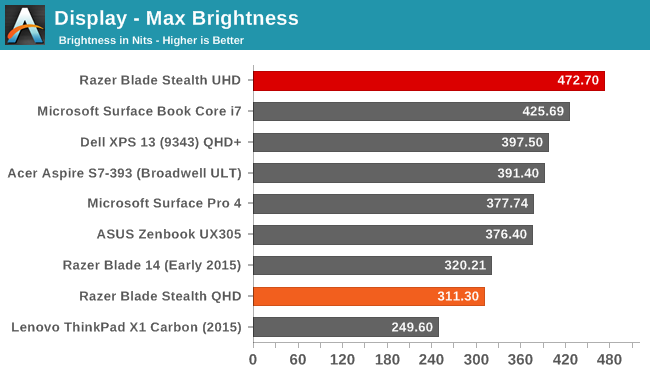
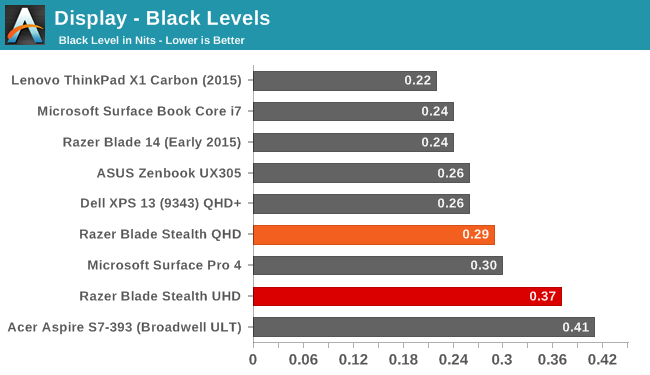

Both panels do well here, but the UHD one is amazingly bright. In fact I'd say that it's almost smartphone bright. It’s not every day a laptop that can hit almost 500 nits lands on my desk, and the excellent thing is that it hits this very high brightness level, but also keeps the black levels reasonably in check. 1200:1 contrast is not chart topping, but it’s still very good for a laptop LCD.
Grayscale and White Point
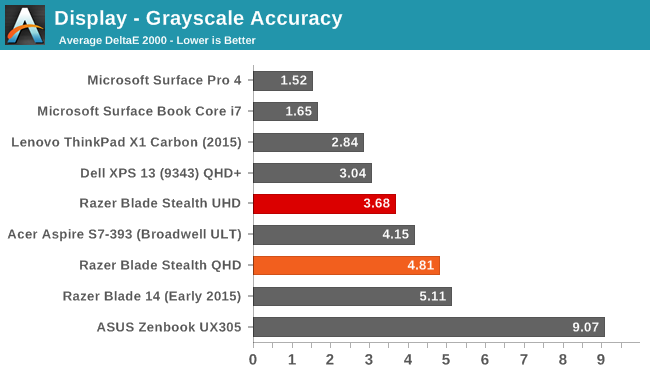
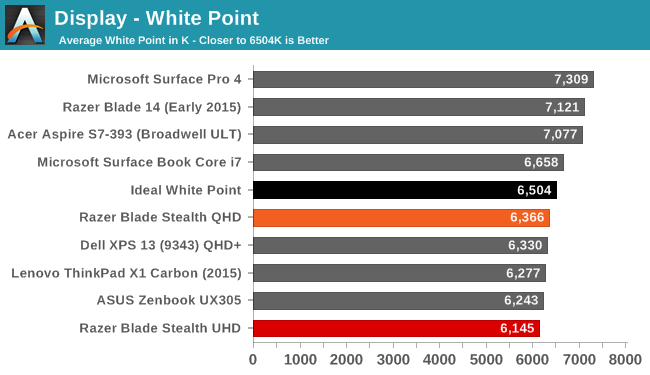
Out of the box, the Razer default ICC profile is available to help correct temperature and grayscale. On the two models I had, the grayscale was not as accurate as I’ve seen in other products from Razer, which due to them not individually calibrating each display. A generic profile can only do so much. What it did help with a lot though was the color temperature. On the QHD version, removing the ICC profile would make the display a lot cooler. Regardless there’s room for improvement here from Razer. Luckily this is the one area where a display calibration can make the most impact. The QHD model in particular had some issues very early in the range.
Saturation
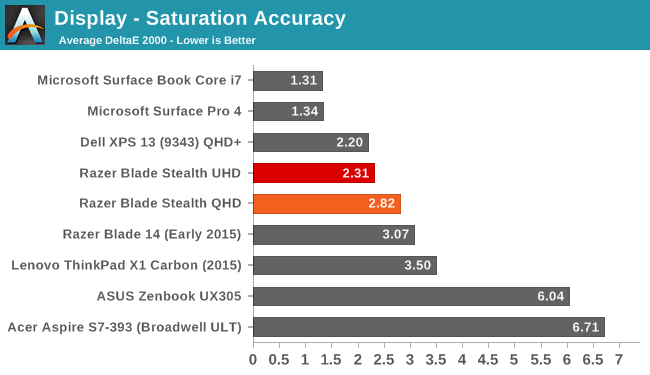
Luckily the issues with grayscale were relegated to just that. On the saturation sweeps, the display is much more accurate in the target color space. Here it is clear how much larger the color space is on the UHD model. Both displays can pretty much hit the entire gamut they are targeting, whether it be sRGB on the QHD one or Adobe RGB on the UHD display.
Gretag Macbeth
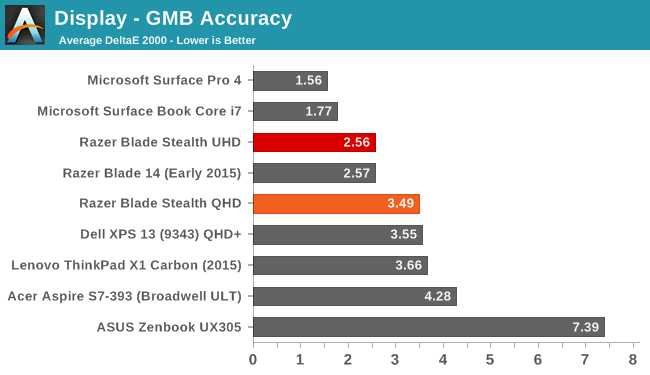
The most comprehensive test is the Gretag Macbeth colorchecker, which tests a wide range of colors including quite a few of the flesh tones. Both displays do ok here, with the UHD model coming in a bit better again.
Color Comparator
To get a feel for what the numbers mean, the following images are relative color comparisons, with the target color on the bottom half of the swatch. This is relative because any inaccuracies in your own display will skew the target color, but it does put a visible difference on what the results of the display testing mean.
Both QHD and UHD displays are off when it comes to the gray tones, as expected with the earlier grayscale results, but the colors are more in-line with what they should be.
Display Conclusion
It’s great to see Razer continue their partnership with Sharp and include IGZO-based LCDs in both models. The IGZO displays continue to offer great color reproduction, and the more transparent TFT of IGZO lets plenty of the backlight through. Hitting almost 500 nits is impressive, and at a pixel density of 352 pixels per inch, it’s even more impressive.
That being said, the included ICC profiles did not correct for grayscale, and both the QHD and UHD versions need some help on that. Clearly Razer was aggressively targeting a price point, but both of the displays are nowhere near where they should be on gray.
The final piece is the Adobe RGB support on the UHD model. Until such a time as Windows can properly handle larger gamut displays, it would have been prudent to include software to pick the color space as necessary. Having only Adobe RGB support is not ideal in our current sRGB world.


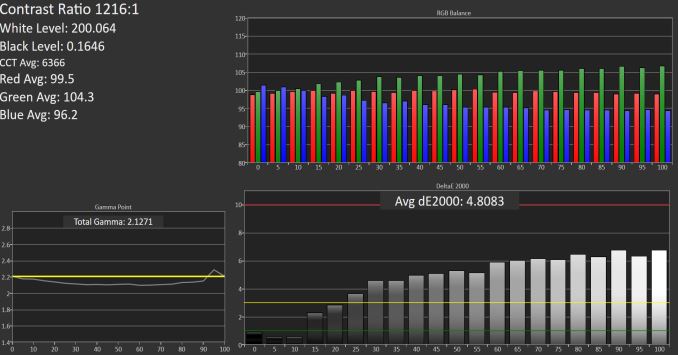
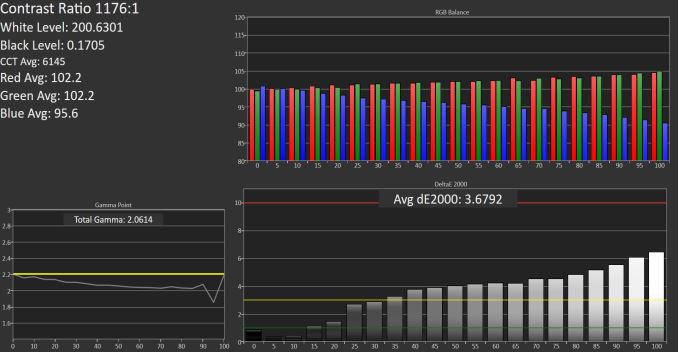
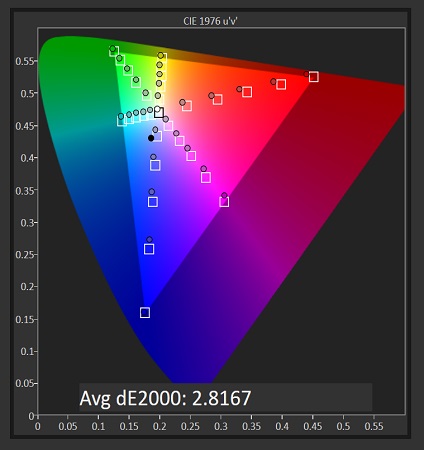
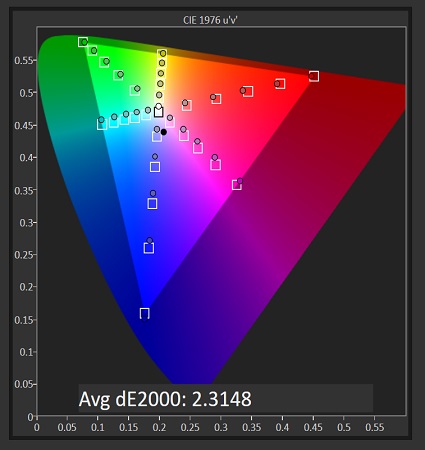
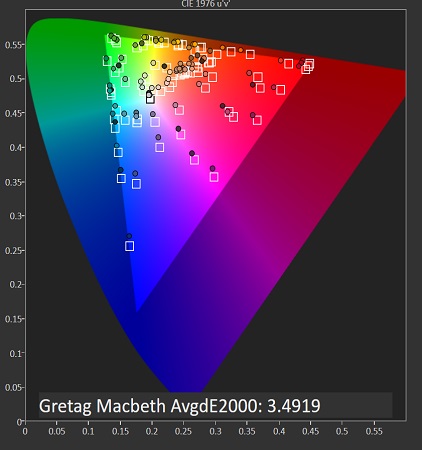
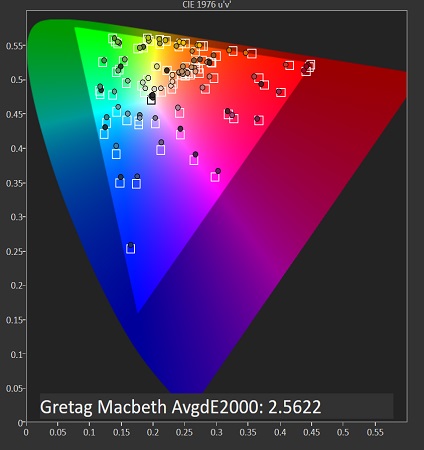












66 Comments
View All Comments
ImSpartacus - Tuesday, March 29, 2016 - link
The battery life is disappointing, but at least seems to be alright otherwise.The keyboard appears like overkill, but at least you can presumably switch to a clean white light.
Keao - Tuesday, March 29, 2016 - link
It is overkill if you just want an ordinary ultrabook indeed. Needs to see if the glowing razer logo on the back can be deactivated too. (You can switch to plain white for sure given it works like the blackwidow chroma that I have)Battery life is really not great but is OK for the kind of processor they have isn't it? What's putting me a lil' off is the fact that to make it a gaming machine you do need to shell out at least some 750 additional bucks. Sure the external case will be re-used supposedly but I'm unsure about the future of this solution (Can evolve quite fast with a new Thunderbolt version and/or replacement of the PCI-e interface?)
zeroqw - Tuesday, March 29, 2016 - link
"Battery life is really not great but is OK for the kind of processor they have isn't it?" nope.. there are quite similar ultrabooks with at least 50% more battery life.Razer put a small battery in the laptop and if you add the backlit keyboard+glowing razer logo to the equation it just makes it even worse. Too bad because I love the design but the battery life is a deal breaker for me.
Duraz0rz - Tuesday, March 29, 2016 - link
You can turn off the logo LED thru Synapse.TheinsanegamerN - Tuesday, March 29, 2016 - link
Wont fix the battery being too small.DanNeely - Tuesday, March 29, 2016 - link
The battery size isn't the main problem; it's in the same general class as other 13" ultrabooks. The problem is that the laptop's efficiency is bad; if they were able to match their competitions efficiency they'd pick up an extra hour or two bringing the QHD model up to the average for a laptop of its size; and leaving the 4k one with only the penalty related to its ultra high res display (both more GPU work to drive it, and more transistors in the panel blocking a larger amount of the backlight).ImSpartacus - Tuesday, March 29, 2016 - link
I think Razer is struggling with both the pixel race and needing to justify the existence of Core.Honestly, a 768p display would be perfect for a 12.5" laptop (maybe 900p for a buy-up). But then you could say that Razer should've made the Core a smidge thicker and put a modest dGPU in there for gaming.
Spunjji - Wednesday, March 30, 2016 - link
Couldn't disagree more about the display. The sooner we get rid of low-DPI panels and the software ecosystem is forced to accept their existence, the better. The problem here isn't the display, it's a lack of engineering experience regarding power efficiency at Razer.BrokenCrayons - Wednesday, March 30, 2016 - link
I disagree with that. Higher resolution displays, while nice looking, offer little to no added functionality after reaching the point where it becomes necessary to scale the interface in order to retain visibility of objects displayed in it. At this point, they're part of the specifications for the sake of specifications war that's vital for product differentiation and marketing, but that's where it ends. Sacrificing capability as in the case of battery life to achieve a pointlessly high resolution shows particularly poor engineering. An Intel GPU in a 12.5 inch laptop display that is unable to drive games at much lower resolutions should be paired with a 1366x768 panel of decent quality with good viewing angles. Anything more than that won't benefit the end user regardless of how much they think they need more pixels.JoeyJoJo123 - Wednesday, March 30, 2016 - link
>should be paired with a 1366x768 panel of decent quality with good viewing angles.Except that's the thing. In the year 2016 there is no such thing as a 1366x768 panel of anything remotely decent quality. Panels of this size are just churned out by the factory for extremely low cost/low margin devices such as $300 laptops at Walmart.
If you're paying ~$1500 for a premium laptop, you should expect an arguably premium display. If you can't play the game at 2560x1440, then run the game at reduced settings, and if that's not enough, begin lowering the resolution, too.
Paying ~$1500 for a premium laptop also comes with the inherent notion you're paying for premium battery life, but you're not getting that here, either.
Replacing a good screen on a laptop with a bad battery leaves you with a laptop with bad screen and bad battery and now you have an even worse value proposition than before.